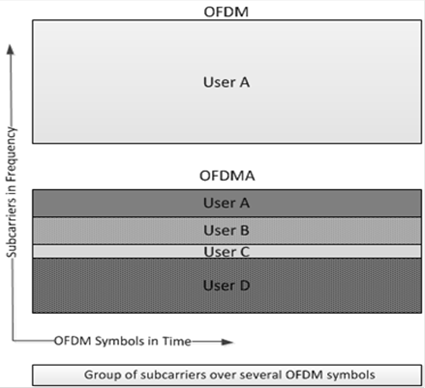Channel coding and framing, QAM and OFDM. Up to 11 Modulation and Coding Scheme (MCS) defined.
-
BCC and LDPC coding for forward error correction.
-
More PPDU formats defined to support multi-user case. The overhead for multi-user case would be higher compared to single user case.
-
Up to 1024QAM to increase the data rates.
-
OFDM with reduced sub-carrier spacing (4x symbol length of 802.11ac) and more variable CPs for flexibility to support different scenarios, especially long outdoor channel, considering tradeoff between efficiency and robustness.
Spatial reuse by dynamic power control and beamforming to reach an optimal tradeoff between individual transmission rates and the number of concurrent transmissions that maximize the area throughput.
Multi-user operation by OFDMA and SDMA.
-
OFDMA, where multiple-access is achieved by assigning subsets of subcarriers to different users, allowing simultaneous data transmission by several users, and each group of subcarriers is denoted as a resource unit (RU). The RUs can be allocated to stations depending on their channel conditions and service requirements, and an OFDMA system can potentially allocate different transmit powers to different allocations.

-
MU-MIMO. Both downlink and uplink MU-MIMO transmissions are supported on portions of the PPDU bandwidth (on resource units greater than or equal to 106 tones) and in an MU-MIMO resource unit, there is support for up to eight users with up to four space-time streams per user with the total number of space-time streams not exceeding eight.
-
OFDMA+MU-MIMO, Potentially can be used.